Vacationing with — or without — loved ones can be any number of things: daunting beforehand, exciting or stressful during, or fulfilling overall. In short, it can induce a whirlwind of emotions. This makes sense given the many ways people approach to travel. Indeed, your personal mindset, what you hope to accomplish during the trip, and any number of other factors may influence your experience. What sort of travel style is a good fit for you? More specifically, are travelers who plan every step of the way likely to have significantly different experiences than more spontaneous travelers?
Key Takeaways
- Nearly 40% of travelers went over budget on their latest trip
- Florida was the U.S. state most visited by spontaneous travelers
- Compared to spontaneous travelers, planners were more than twice as likely to have experienced stress on their most recent trip
In an attempt to further explore these considerations, we surveyed a group of 1,000 people about how they travel. This article uses insights drawn from the resulting data to understand how someone’s travel style relates to the activities they engage in at their destination, who they travel with, and how effectively their budgeting aligns with that of their travel partner or group. Read on to find out more!
Types of Travelers
For the purpose of our survey, we came up with two categories: planners and spontaneous travelers. Planners were those who preferred to have all the details and intricacies of their trip nailed down in advance, while spontaneous travelers were more likely to trust their instinct at a moment’s notice. In the first section of our study, we wanted to see how many people identified with each category and how that had impacted their most recent excursions.
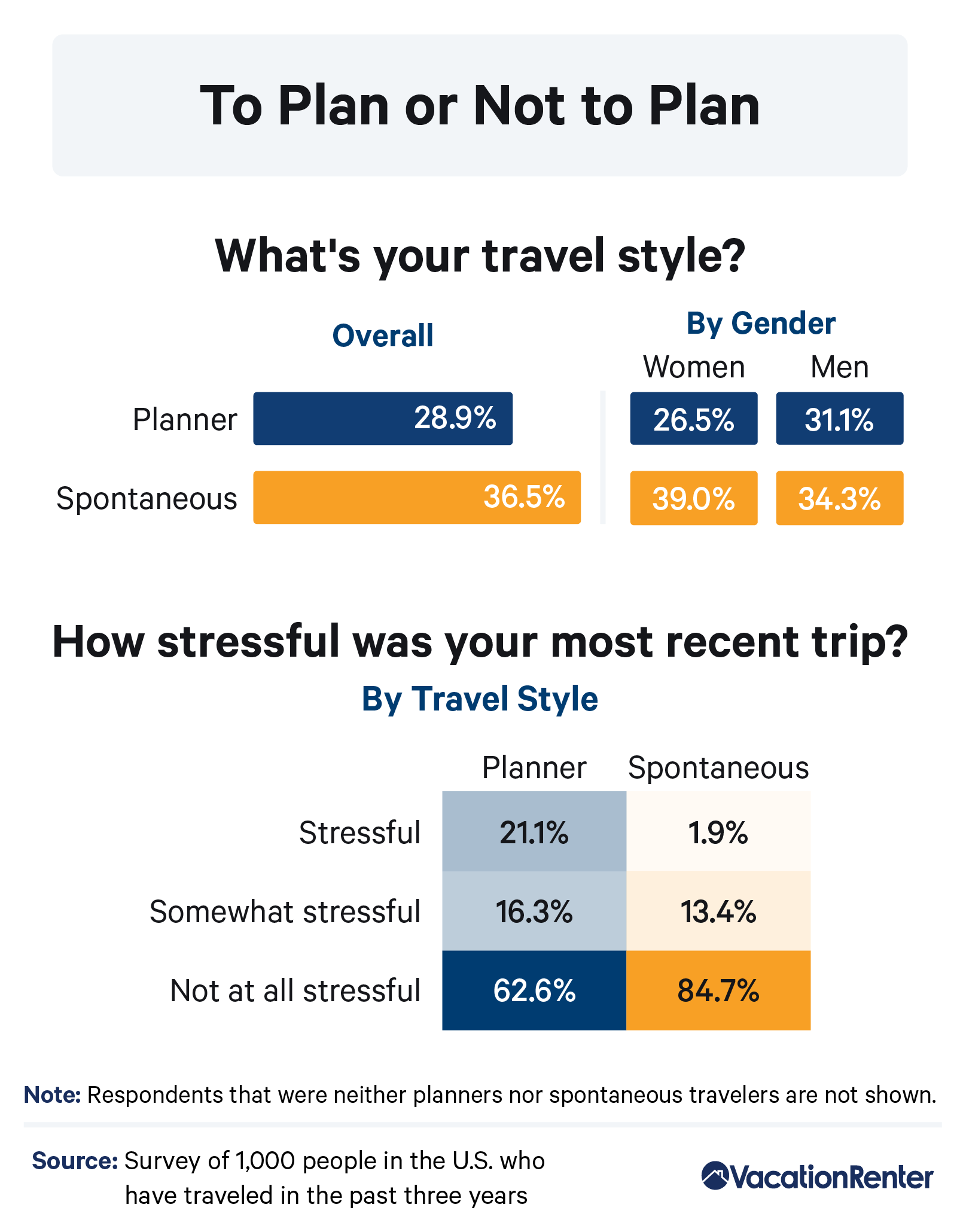
We found that the majority of respondents identified as spontaneous, with 36.5% falling into this category, while 28.9% could be identified as planners. Respondents that fell between the two categories made up the rest of the respondents.

When the results were broken down by gender, the differences between men and women weren’t drastic. Nevertheless, it turned out that the most popular travel style for women was spontaneous, while men were slightly more likely than women to be planners. This might be surprising, given that women are often in charge when planning out trips for their families.

The level of spontaneity translated directly into the quality of the trip. Although planning ahead poses obvious benefits, there is a strong emotional downside. While 84.7% of spontaneous travelers reported enjoying an entirely stress-free trip, only 62.6% of planners could say the same. Moreover, the planners were more than 11 times more likely to call their entire trip “stressful.” Spontaneous travelers have the advantage overall, as travel stress can cause side effects such as fatigue or nausea, definitely putting a damper on anyone’s trip.

Instead of deciding that planning ahead is a bad idea — Benjamin Franklin is famously quoted as saying “those who fail to plan are planning to fail” — these travelers can simply look to their spontaneous counterparts to remember that the trip can still be enjoyable even if all does not go exactly as planned. Perhaps it was not the plan itself but the unwillingness to diverge from the plan that brought on the stress. That said, more research is required, so keep reading to see what else we uncovered.
Itineraries of Planners & Spontaneous Travelers
With travel personality types so heavily influencing stress levels, we next wanted to know how able (or unable) each type was to enjoy the overall travel experience. This piece of our study asks respondents to rate their level of enjoyment for their most recent trip, which we compared once again by traveler personality styles.
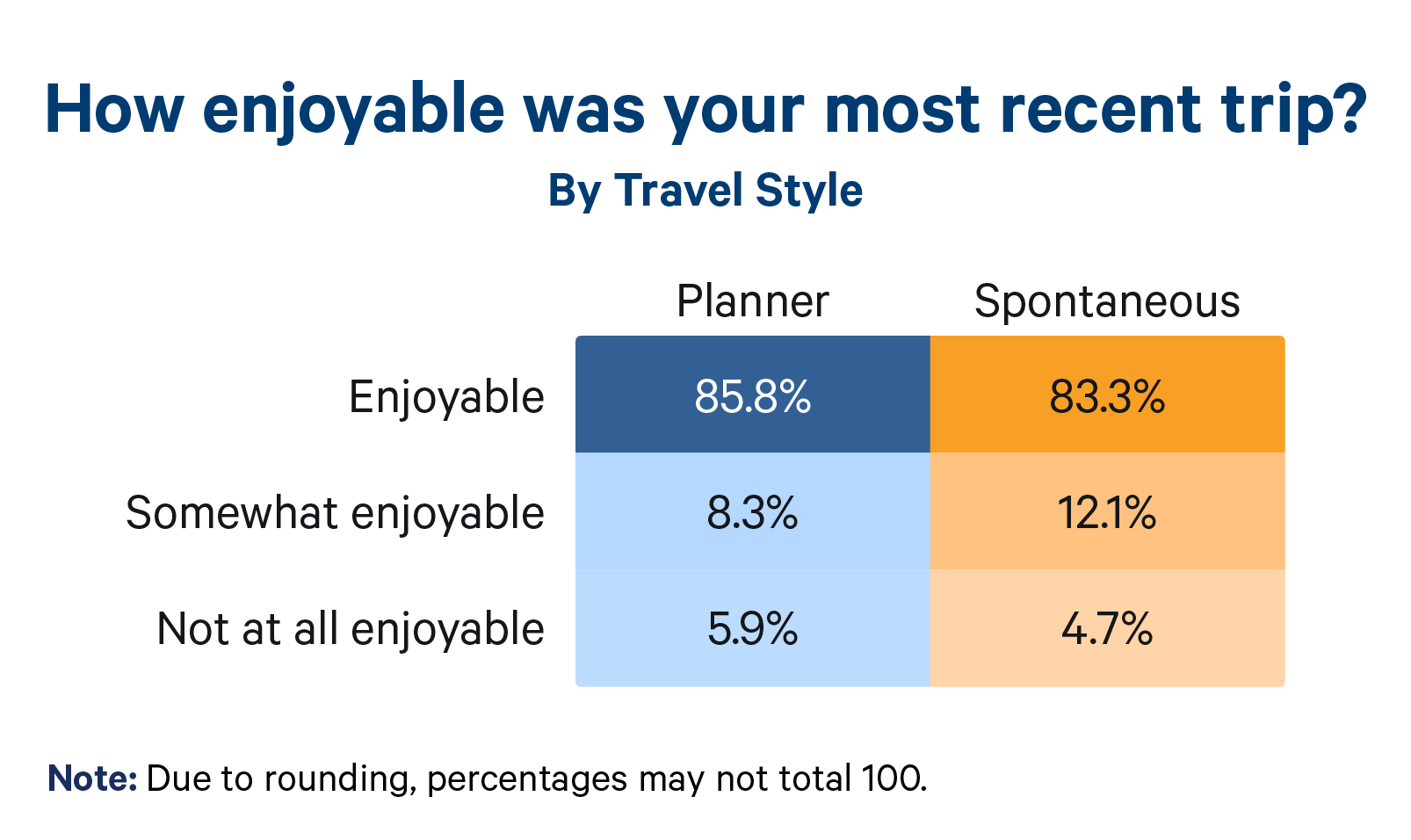
Based on our survey, planners were more likely to rate their overall trip as enjoyable. Evidently, putting up with the stress of a plan can be worth it and enable travelers to get the most out of their trip. That said, 83.3% of spontaneous travelers still rated their trip as enjoyable. Planners may pour hours into planning the perfect experience, but it’s a comfort to know that spontaneous travelers enjoy their trip almost just as much, without pouring all their time and energy into pre-planning their trip.
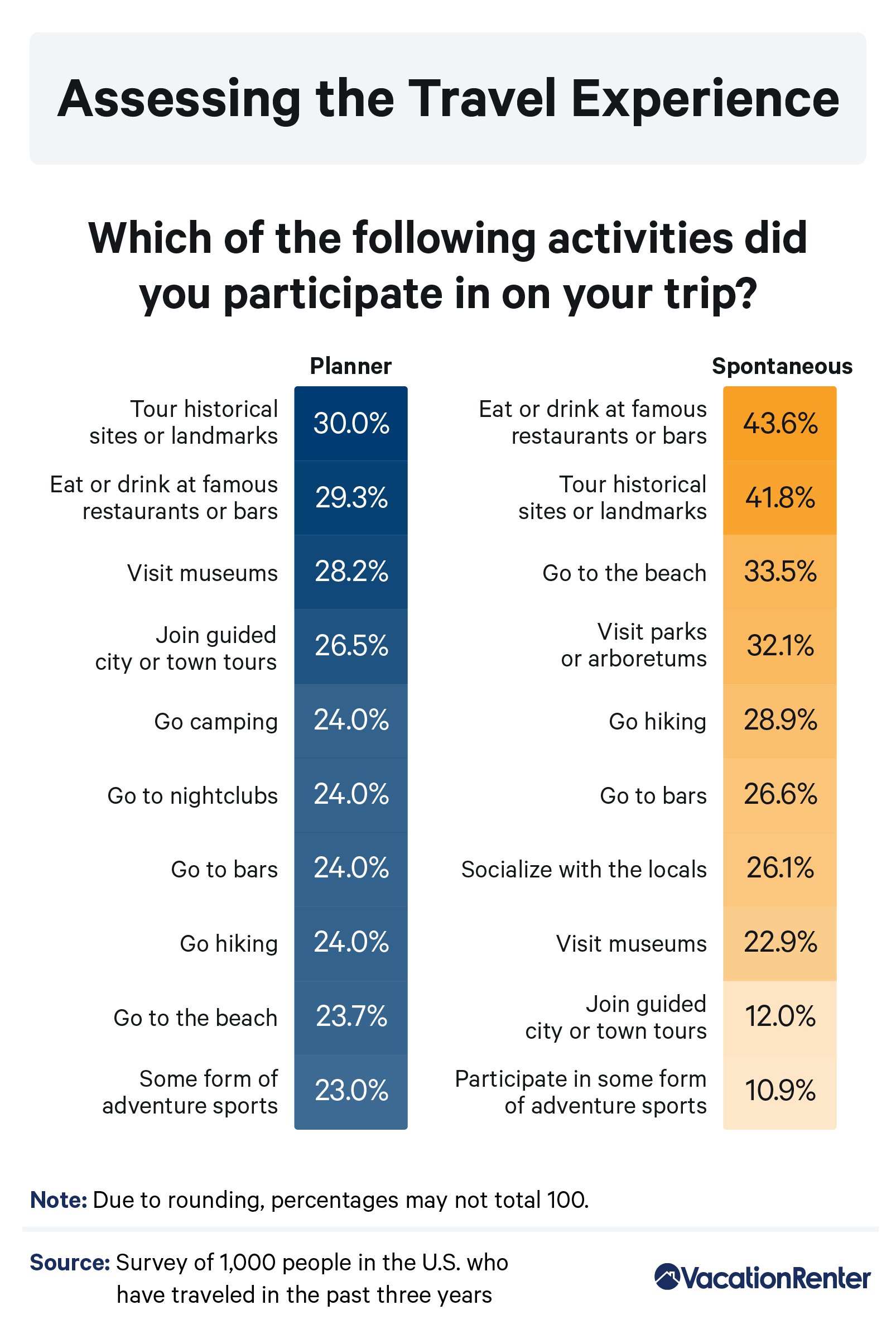
Depending on the hopes for the trip, it may be necessary to adopt the travel style best suited to the destination. While planners were primarily interested in things like touring historical sites and landmarks (30%) or visiting museums (28.2%), spontaneous travelers were more likely to prioritize drinking at famous bars (43.6%) or going to the beach (33.5%). Visiting museums and historical sites often requires a specific combination of timing, tickets, reservations, and exhibition scheduling — all of which are highly unlikely to go seamlessly without a plan, and take quite a bit of mental energy to organize.
It’s easy to see why the spontaneous types may have preferred the bars or the beaches — they’re easily accessible and enjoyable without any type of stressful planning ahead. They also speak to more of the laissez-faire lifestyle that this personality type may be more likely to enjoy. While more impulsive respondents did often report wanting to see historical sites as well, recall that their enjoyment levels were lower — albeit marginal — than those of planners, and they were perhaps more likely to confront logistical errors trying to fulfill these desires without a plan.
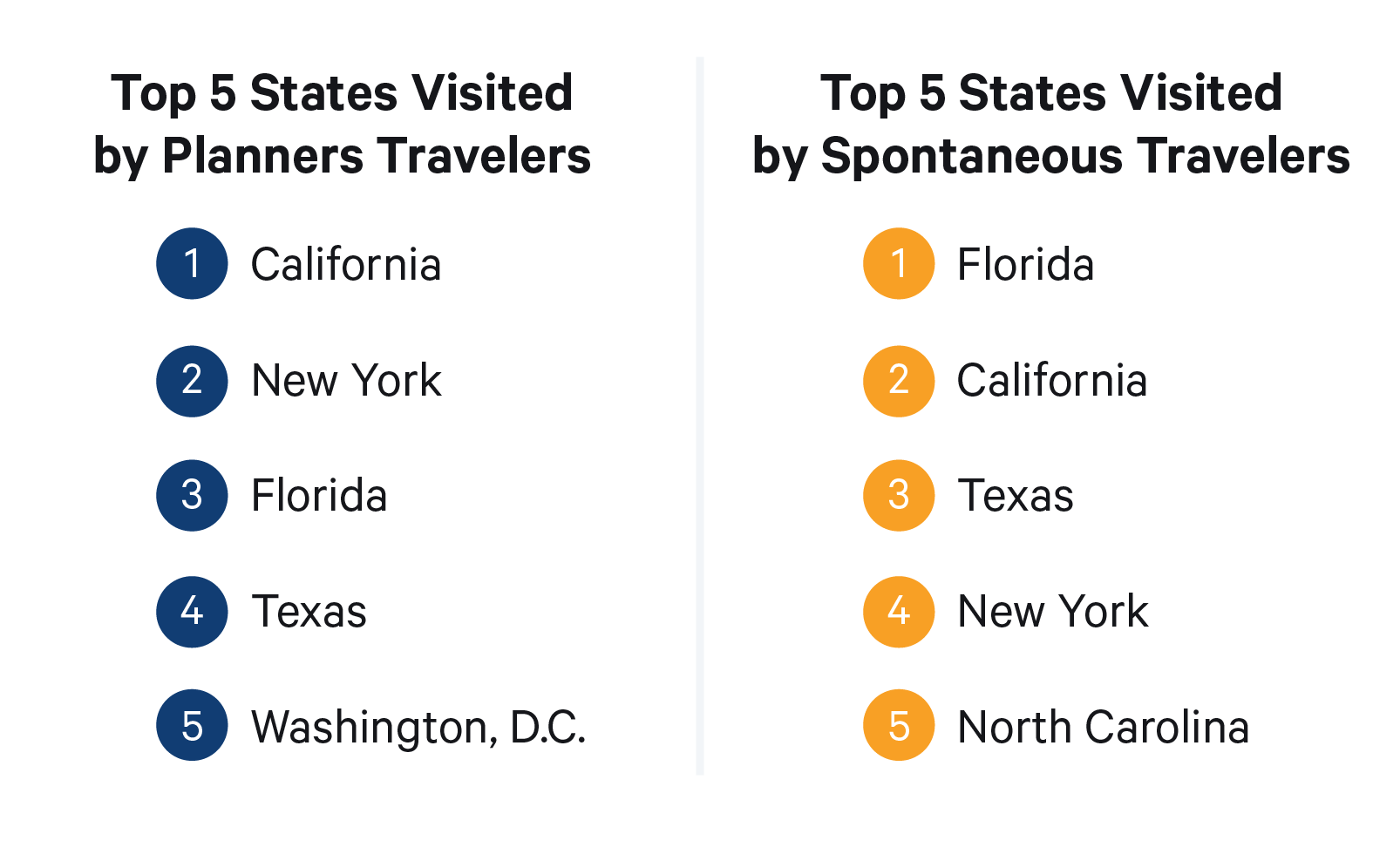
Planners and spontaneous travelers not only preferred different activities but different states entirely. California was the No. 1 state of choice for planner types, while the laissez-faire crowd ventured most often to Florida. While both Florida and California offer beaches and warm climates, California does draw travelers for a wider berth of reasons and offers planners more of their beloved landmarks to tour, all of which likely involve logistical organization. California is also a more expensive location to visit, and may require additional planning specifically for finances. Nevertheless, California offers spontaneous travelers plenty of famous locales that are much easier to access (such as Venice Beach, Route 1 and 101, or the Golden Gate Bridge).
Spontaneous travelers were also more likely than planners to pick Texas for travel. Evidently, a warm climate makes for a smooth plan-free trip. Places like New York, which has harsher weather conditions, were much less likely destinations for this group. With desires for bars and beaches in mind, Washington, D.C., didn’t even make their top five choices, but did manage to crack the top five for planners, with its wealth of museums and historical landmarks for them to visit.
Travel Buddies
More often than not, it’s enjoyable to share travel experiences with others — except for when it isn’t. Now that we’ve examined some activities different types of travelers engage in, let’s take a look at who our respondents vacationed with and how it impacted their relationship with them.
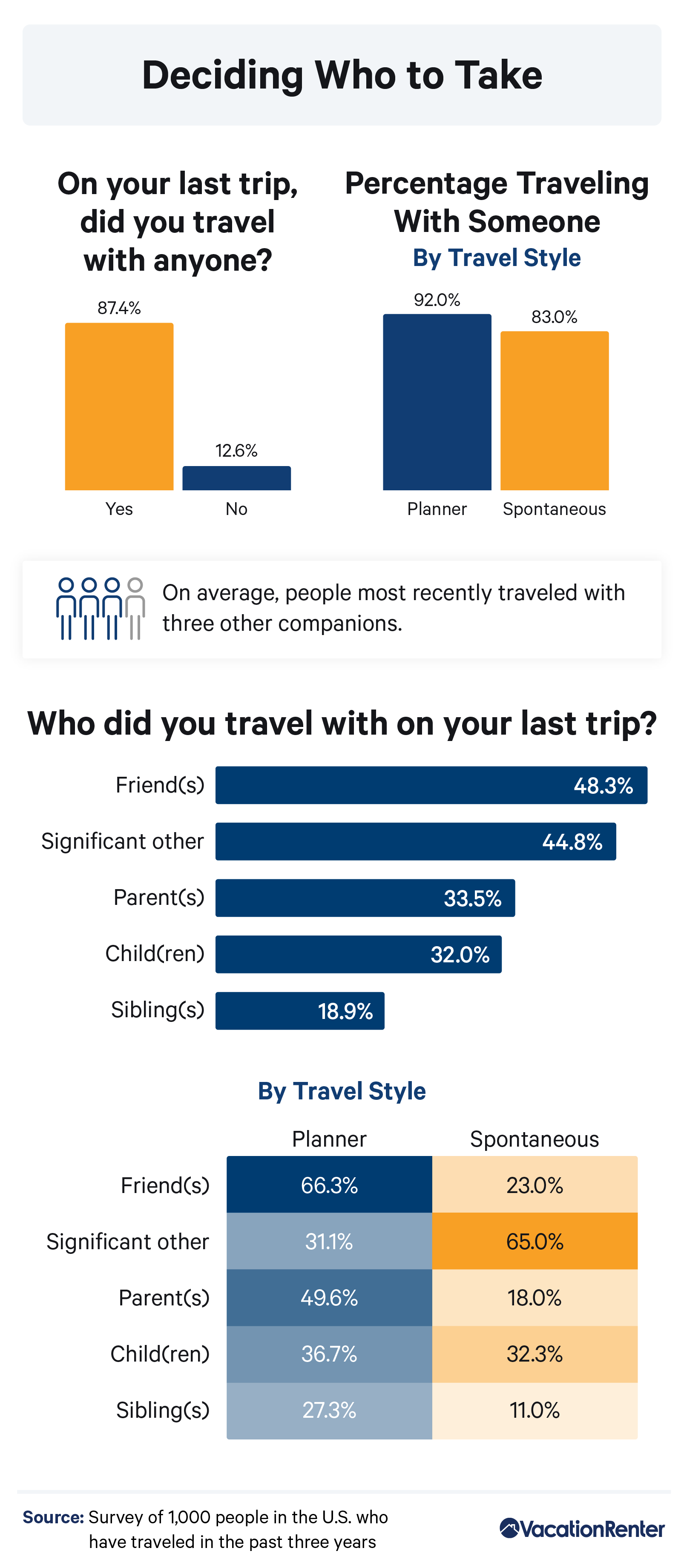
As you might have guessed, traveling with others is common. So common, in fact, that 87.4% of our respondents reported traveling with at least one companion on their last trip, with the average being three companions. When answers were broken down by travel style, it was more common for planners to travel with someone — a habit attested to by 92% of planners in comparison with 83% of spontaneous travelers. This makes sense when one considers that an almost nonexistent agenda might not equitably serve the interests of an entire travel group. And it’s much easier to travel spontaneously and stress-free when only worrying about oneself.
As far as who our respondents chose to travel with, it appeared that certain companions were more popular than others. By quite a large margin, friends and significant others were the most popular travel companions, as voted for by 48.3% and 44.8% of respondents, respectively. When answers were broken down by travel style, planners were most likely to travel with their friends, followed by parents in second place. One potential explanation for this could be that planners enjoy sharing their vision and setting up experiences for their friends and loved ones. However, to make a trip with a larger group successful, a planner keeping track of everything and organizing transport, accommodation, or tickets is invaluable!
On the other hand, significant others were the top choice for spontaneous travelers, followed by children. Last-minute getaways or impromptu trips could be a reason that spontaneous travelers travel with their partners or families the most. Especially when traveling with children, being spontaneous can pay off. It’s much easier to take a last-minute trip to make sure that everyone is in a good mood, and ready to enjoy some quality family time, and avoid those tricky tantrums.
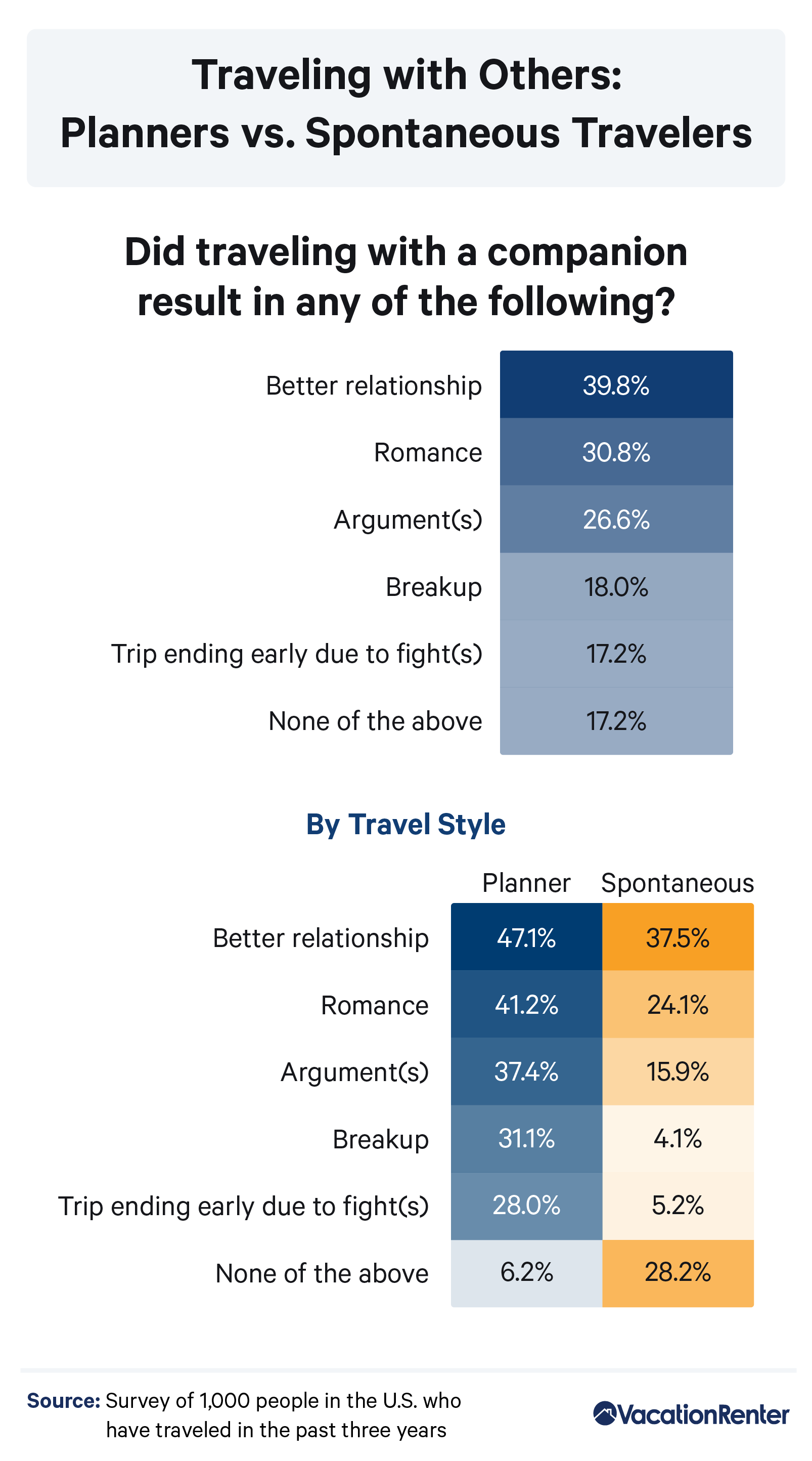
When it came to how shared trips affected respondents’ relationship with their companion(s), the results were ultimately positive. Regardless of travel style, improved relationships and romance were the experiences most frequently reported.
Show Me the Money!
As any seasoned traveler surely knows, expenses can add up. Just getting to your destination can often be a hefty cost in itself. We examined how our respondents fared compared to their companions when it came to budgeting and drew some interesting insights.
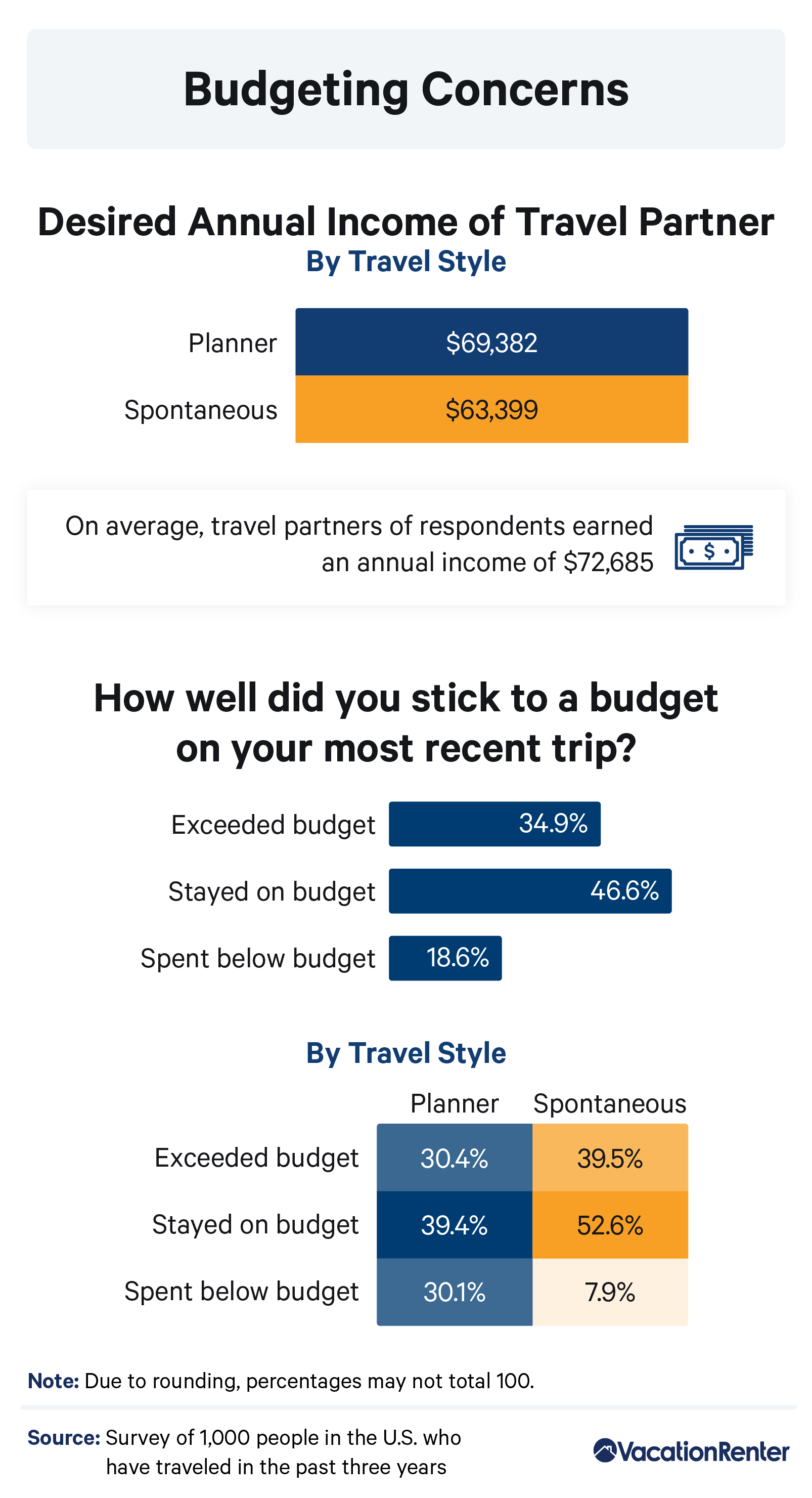
According to our survey data, the average income of travel companions was just under $72,700. This turned out to be more than most were looking for in a travel partner. Regardless of travel style, respondents indicated that the annual income of their dream travel partner fell in the $63,000 to $71,000 range. Furthermore, spontaneous travelers were looking for travel partners that earned at least $63,400 in a year. Talking about money is never easy, but given how expensive traveling can be, it’s a crucial aspect when traveling with someone else. In this instance, planners may be looking for someone who can spend upfront on costs such as event tickets or museums with funds left over, while spontaneous travelers are more open to traveling on a whim with a budget.
When looking at budgets, it turned out that nearly 47% of respondents were able to stay on budget. Meanwhile, just under 35% spent more than they budgeted, and about 19% spent less than expected. While more than half of spontaneous travelers stayed within their budget, almost 40% overspent. Who knew, sometimes having a plan can even save you money!
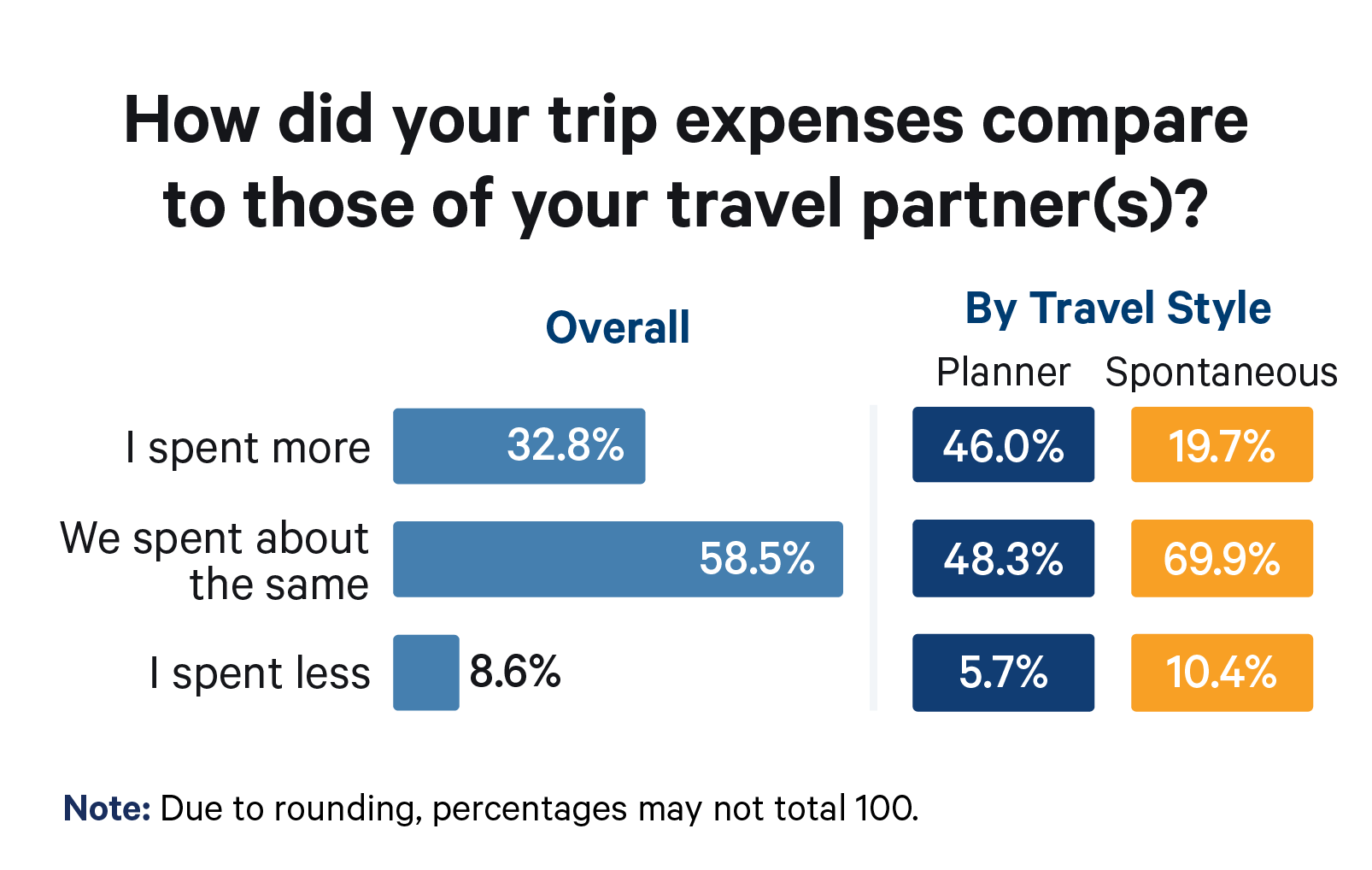
Almost 7 out of 10 spontaneous travelers spent the same amount of money as their travel companions. As this group was most likely to travel with immediate family members, it makes sense that a fair split of expenses takes place. Planners, on the other hand, were most likely to spend more than their companions, with 46% reporting having done so. Planners will most likely be in charge of making reservations and putting down deposits, which could increase the amount they have to spend on their trips, possibly contributing to the high levels of travel stress as well.
The Best of Both Worlds
As it turned out, it appeared the most popular and cost-effective travel style was spontaneity. Overall, however, the major difference in travel styles was highlighted most dramatically by the difference in popular activities in each of the two groups’ itineraries. While more than half of spontaneous travelers stayed within their budget, almost 40% overspent. Who knew, sometimes having a plan can even save you money! If a guided tour or museum visit sounds appealing, perhaps a planned trip might be more up your alley. If you prefer a balance between the two, then by all means, get the best of both worlds.
As we’ve seen, trip planning can be considerably stressful and time-consuming. VacationRenter is here to take the stress out of finding the perfect spot for your much-needed and well-deserved getaway. All you need to bring to the table is your destination. VacationRenter provides the best rentals from the top sites all in one place, so you can spend more time enjoying your vacation and less time trying to make it happen. Whatever tools you need to start your search, VacationRenter is here to support you.
Mentioned In This Article
- Visit NC: See Wild Horses Roam Free on the North Carolina Coast
- Reader’s Digest: 12 Etiquette Rules You Must Follow When Traveling with Friends
- Where the Road Forks: Solo Travel vs. Group Travel: Pros and Cons
Methodology
This study uses data from a survey of 1,000 people located in the U.S. that have traveled in the past three years. Survey respondents were gathered through the Amazon Mechanical Turk survey platform where they were presented with a series of questions, including attention-check and disqualification questions. 45.9% of respondents identified as men, while 54.1% identified as women. 15.1% of respondents were Gen Zers, 47.2% millennials, 22.3% were Gen Xers, and 15.4% baby boomers. Respondents ranged in age from 18 to 74 years old with an average age of 34. Participants incorrectly answering any attention-check question had their answers disqualified. This study has a 3% margin of error on a 95% confidence interval.
Please note that survey responses are self-reported and are subject to issues, such as exaggeration, recency bias, and telescoping.
Fair Use Statement
Given the seemingly infinite ways to spend your trips, it’s certainly to your advantage to further this discussion. If you find our data useful, feel free to spread the knowledge. Just make sure you do so for non-commercial use and provide a link back to our site when doing so.